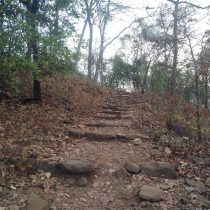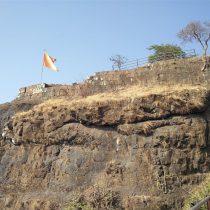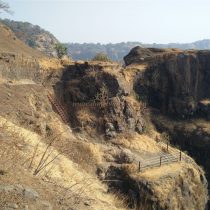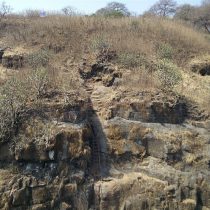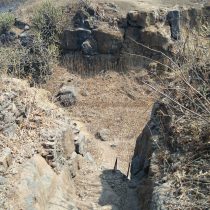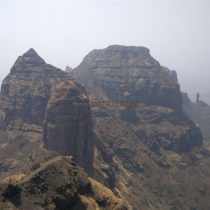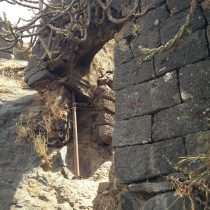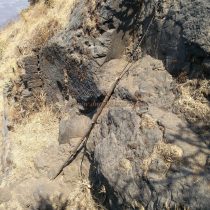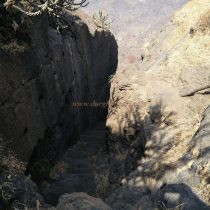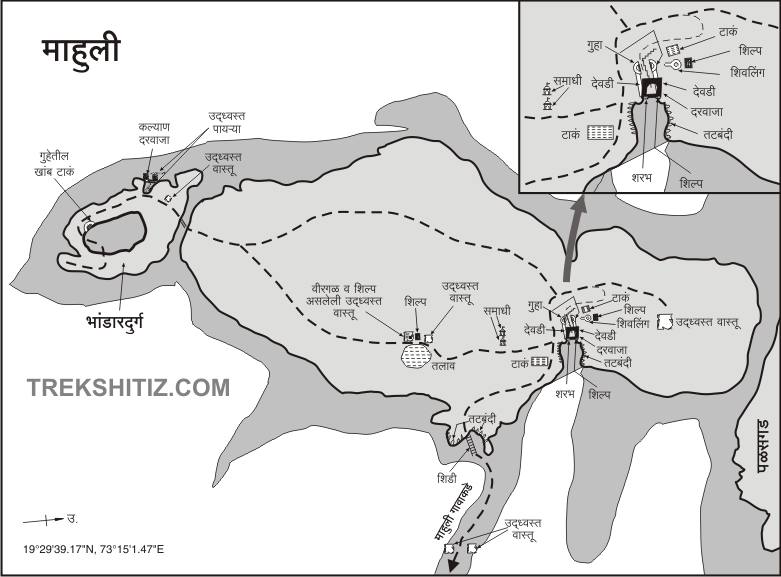BHANDARGAD
TYPE : HILL FORT
DISTRICT : THANE
HEIGHT : 2680 FEET
GRADE : HARD
Mahuli Fort is a famous place for a one day trip in Shahapur taluka near Mumbai-Thane. This place is constantly bustling with tourists. This fort is situated in the mountains of Sahyadri and is fortified. There is a group of three forts here, namely, Mahuli, Bhandargad, and Palasgad. These three forts are separated from each other by a ravine, with Mahuli at the center, Palasgad at the north, and Bhandargad at the south. All these forts have separate gates and different ways to reach up. The Mahuli Fort in the middle is the largest and has access to Bhandargad and Palasgad. If you plan your time well, you can stay at the base of the fort the day before and start early in the morning the next day. You can see all the three forts in one day and return to the base of these forts in the evening.
...
As Mahuli, Bhandargad, and Palasgad are three separate forts, they are not described together. Most of the fort lovers who visit the fort visit the main gate of Mahuli fort and its surroundings and walk back from there. Very few of these fort lovers go to Bhandargad, that is why in this article I have tried to introduce Bhandargad separately. To visit Palasgad from Mumbai-Thane, you have to reach Mahuli village at the foot of the fort from Asangaon on the Thane-Nashik highway. The distance from Mumbai is 77 km and from Thane, it is 55 km. Tourist accommodation has been built for the tourists to stay here and the Ganpati temple and the temple of Lord Shiva in the village also have accommodation facilities. There are three old temples in the settlement at the foot of the fort, one of which belongs to Lord Ganesha, the other to Lord Shiva, and the third to the village deity. There are some carvings scattered in the temple premises. Apart from this, a lake from the medieval period can be seen in the village. After visiting the Shiv temple, a road goes to the right at the back of the temple. There is a Ganesh temple a few minutes away on this road and drinking water is available at the hand pump in front of the temple. In the courtyard of Ganesha temple, one can see a stone dome and a partially broken hero stone. Crossing the newly constructed arch along this path, we reach the newly constructed tourist center by the forest department. To reach the fort, one has to pay an entrance fee of Rs. 20 per person. The way to the fort passes through this tourist center. The fort is crowded with tourists and you need to climb on this sparsely forested road. After crossing the hill and stream in front of the tourist center, we reach a small surface. Remains of some structures can be seen in this place. During the Peshwa period, at the foot of the Mahuli fort, there are mentions of some chief’s offices and mansions, which are probably the remains of these structures found on the surface. In this way, in about two hours we come under the edge of Mahuli by doing easy rock climbing in 2-3 places. The ramparts of the fort in this place still standing and an iron ladder about 15-20 feet high has been installed to climb the edge and the ramparts. After climbing this ladder and crossing the ramparts, you enter the Mahuli fort. There are different ways to reach the fort such as Mahadarwaja, Hanuman Darwaja, Kalyan Darwaja, vandre khind, Palasgad, and Mahuli khind. Although the ladder route we came from Mahuli village is not the official route to the fort, at present it is the easiest way to reach the fort. Since Bhandargad is our objective here, without describing Mahuligad, only a brief description of the remains seen on the way is given. After crossing the ramparts, a straight path leads you to the main gate of Mahuli fort. The first thing you see on this road is a water cistern carved in the rock. The water in this cistern is not potable. After walking for 5 minutes on this path, the fork on the left side of this path is noticed. Here an arrow leading to Bhandargad is painted on a board hanging on a tree. This is the way to Bhandargad. Turning left on this path, at some distance, you can see three stones of a broken Samadhi piled up. After visiting the Samadhi, on the left side of the road, you can see a large quadrangle structure built of six feet high stone with steps in the Karvi forest. Only the remains of a mansion can be seen here today. The architectural remains around this quadrangle structure are hidden in the Karvi forest. On the way to this quadrangle structure, you can see many relics hidden in the trees. Next, you can see a rectangular carved rock erected on the road, but it is not clear what this rock should be about. Next to this rock is the Shiv temple. The three-sided walls of this temple, which is on a quadrangle structure, are still standing today. On the roof of the temple, there is a Shivling carved on the stone as well as a detached sculpture. In front of the temple is a large dried lake. The fork on the left side of this stone leads to Hanuman Darwaza of Mahuli, while the straight path leads to Bhandargad through the forest. This road reaches the gorge between Mahuli and Bhandargad at the southern end. From this point, there is a beautiful view of the fortifications of Bhandargad and the steps carved in stone to go up to it. To reach Bhandargad, one has to descend 100 feet in a gorge and climb the hill of Bhandargad. There are two ladders to reach Bhandargad in this gorge and since these ladders are wobbly, you should be cautious. There are steps carved in the rock leading to the fort and there should be a small door at this place. With these steps, we reach the top of Bhandargad. The head of Bhandargad is spread over 21 acres from south to north and is 2640 feet above sea level. The fort is overgrown with trees and due to this most of the remains are hidden in the trees or buried in the soil. From here, when you start walking towards the south end of the fort, you can see the quadrangle structures of houses buried in the mud around the road. At one point along the way, you can see footsteps carved on a rock and a Tulsi Vrindavan. A footpath leads down to the west side of the fort. As this road is not easily visible, you should walk carefully. There is the main gate leading to Bhandargad built on the lower side and this gate is known as Kalyan Darwaza. From here, after descending 50 to 60 feet on a narrow path, this door is visible. Inside the door is an inscribed inscription in Devanagari script. The condition of the door is very bad and it is supported by an iron pillar. The way to go down through Kalyan Darwaza has become very difficult as the steps here are broken. There is a rope for support to descend this path. The entire path below it is carved in the rock. There is another inscription on this road in the gorge which has been destroyed. After seeing the door, return to the original path. As you approach this ascending path, there is a muddy lake in the bushes. It contains perennial potable water. After coming from here, the remains of a structure on the left side lead to Bhandargad, the southern end of the fort. The cone of Bhatoba, Navara, and Navri standing in front of Bhandargad, and the cone of Wazir can be seen on the right. Alang, Madan, Kulang, and Kalsubai mountain ranges as well as Tungareshwar and Gumtara forts are visible from the north of the fort, while Harishchandragad, Ajoba and Matheran ranges and other regions are visible to the east. It takes three hours to reach Bhandargad from the foothills and one hour to explore the entire fort. Considering the structure and size of Bhandargad, it must have been used mainly for surveillance and as a protective fort of Mahuli. Although it is not known who built the fort, it came under the control of Malik Ahmed, the founder of the Nizamshahi, around 1485, after the fall of the Bahamani kingdom. In the medieval period, this fort near Kalyan Subha was connected with important places like Nashik, Surat, Junnar, and Ahmednagar. Mahuli gained importance due to its geographical structure. The history of Bhandargad is related to Mahuligad. When the combined forces of Mughals and Adilshahis came to overthrow the Nizamshahi, around 1635-36, Shahaji Raje took refuge in Mahuli fort to save the Nizamshahi. Khanjaman besieged Mahuli. Shahaji Raje asked the Portuguese for help but they refused and then Shahaji Raje surrendered. Later on January 8, 1658, Shivaji Maharaj captured this fort from the Mughals. While giving 23 forts to the Mughals in the treaty of Purandar of 1665, Shivaji Maharaj cleverly gave these combined forts to the Mughals as three individual forts. After that, Manohardas Gaud, the Mughal chieftain, began to rule over Mahuli. He did a lot of construction on the fort. In February 1670, Shivaji Maharaj himself attacked Mahuli to conquer the fort. But fort keeper Manohardas Gaud was alert & out of one and a half thousand Mavals, about one thousand Mavalas were cut down by the Mughals and the Marathas had to be defeated. Manohardas Gaud left the fort of Mahuli out of fear of the Marathas and was replaced by a new fort chief Alavardi Beg. After that, on 16th June 1670, after a siege of two months, Moropant Pingale annexed the trio forts of Mahuli, Palasgad, and Bhandargad. After the death of Sambhaji Maharaj, the fort keeper dwarkoji handed over the fort to the Mughals. As it was difficult to attack the fort and capture it, Marathas put fire amongst the enemies forcing them to quarrel, and took control of the fort in 1735. Later, the second Bajirao handed over the Mahuli fort to the British as per the treaty in June 1817.
© Suresh Nimbalkar

